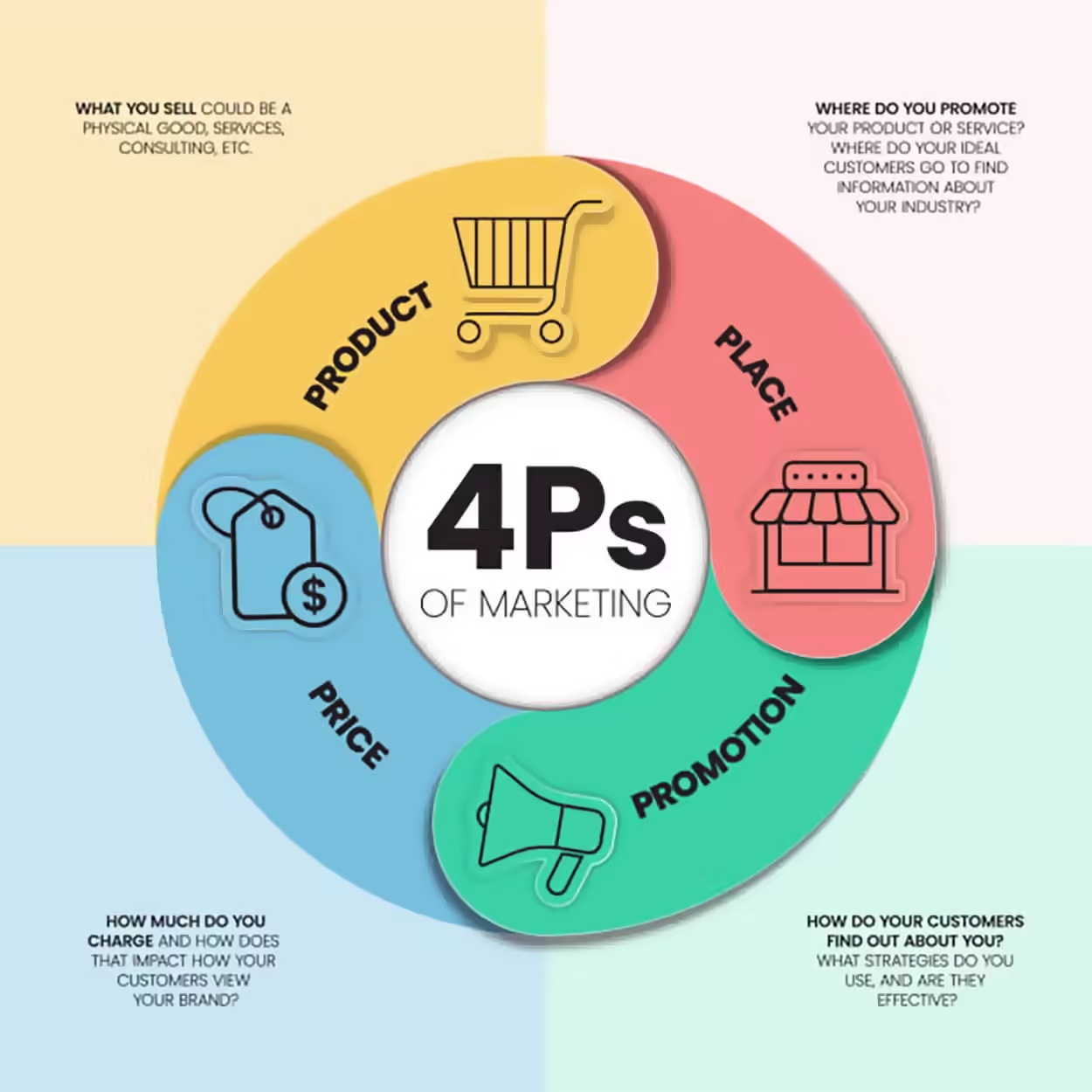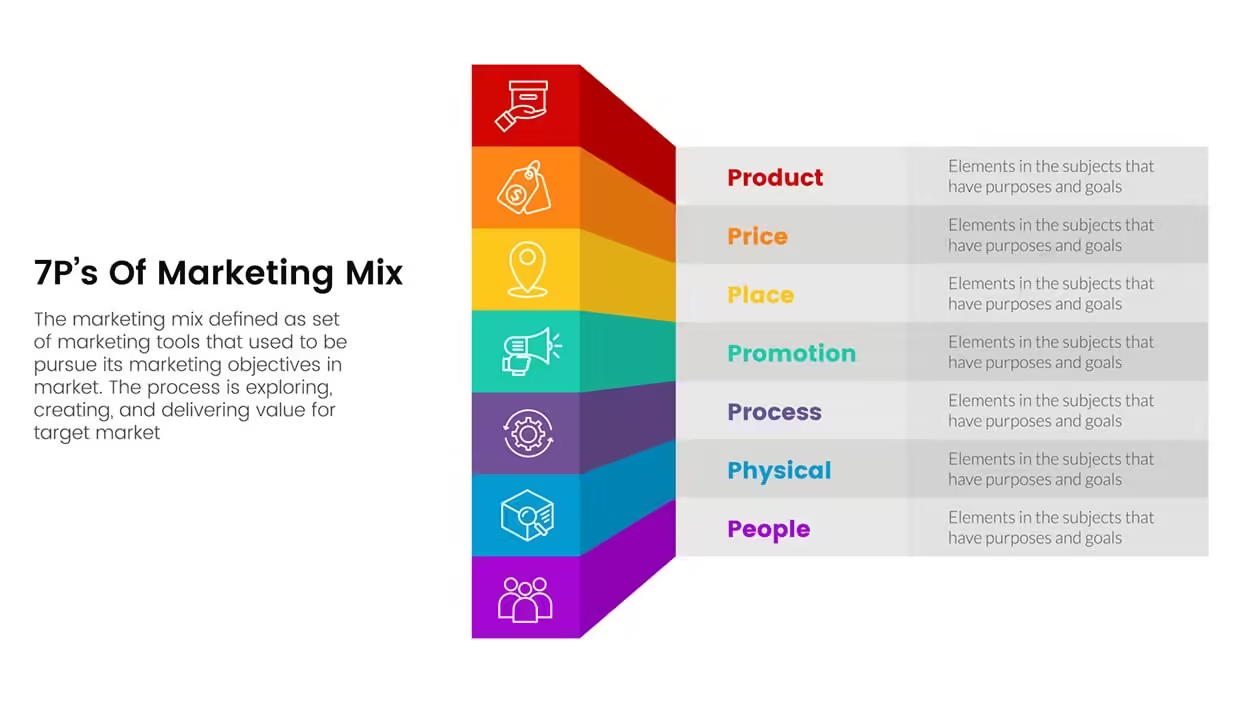Introduction
“Marketing Mix” is nothing more than a mixture of some necessary ingredients to produce a successful recipe called “Business.” Welcome to our blog, where we will explore the marketing mix!
Assume you’re putting together the ideal recipe for a fantastic meal. Just as combining the correct ingredients is necessary for a tasty dish, incorporating the right elements into your marketing approach is important for business success.
In this article, we’ll break down the marketing mix into easy-to-understand components, demonstrating how combining product, price, place, and promotion (plus a few more for service firms) can help your brand stand out and attract new customers.
Whether you’re new to marketing or just want to refresh your strategy, this guide will help you create a winning marketing plan!
What is Marketing Mix Definition | 4 Ps of Marketing Mix
The marketing mix is like your business’s secret recipe. It combines Product, Price, Place, and Promotion to create a perfect strategy for reaching customers. Think of it as the blend of ingredients that makes your marketing efforts successful and tasty!
Here’s how to explain the marketing mix to your client in 15 bullet points with brief explanations:
- The Marketing Mix is a strategic framework, commonly known as the 4Ps (Product, Price, Place, Promotion), expanded to include 7Ps in service marketing.
- Product: This is what you’re selling, whether a physical good or service. It should fulfill the customer’s needs and have unique features that set it apart from competitors.
For example, Apple focuses on creating premium products like the iPhone that emphasize innovation, design, and quality. Apple’s product line constantly evolves to meet customer needs and maintain market leadership.
- Product Life Cycle: The stages (introduction, growth, maturity, decline) that a product goes through, and marketing strategies adjust at each stage to maximize profitability.
For example, Coca-Cola: While its flagship product is in the maturity phase, it introduces new variants like Coca-Cola Zero to extend the life cycle and stay relevant in changing markets.
- Price: The amount customers are willing to pay for your product. Pricing strategies like discounts, premium pricing, and bundling can influence buyer decisions.
For example, Tesla uses a premium pricing strategy for its electric vehicles, positioning them as luxury items. Despite higher prices, customers are drawn to Tesla’s cutting-edge technology and sustainability focus.

- Price Elasticity: Understanding how sensitive your target market is to changes in price. This helps in setting the right price that balances profit and customer demand.
For example, McDonald’s leverages this with price promotions, offering discounts or bundled meals that drive sales without drastically affecting profit margins.
- Place: Refers to where your product is available for purchase. This could be physical stores, e-commerce platforms, or other distribution channels, depending on customer accessibility.
For example, Amazon is a perfect example of a mastering place, providing customers access to millions of products globally through its e-commerce platform and extensive delivery network.
- Distribution Channels: The pathways through which your product reaches the customer, such as wholesalers, retailers, or direct sales. Efficient distribution ensures a wider reach.
For example, Nike sells its products through a combination of its own stores, online platforms, and retail partners, ensuring wide availability to meet customer demand across different regions.
- Promotion: How you communicate the value of your product to your target audience through advertising, social media, public relations, and sales promotions.
For example, Coca-Cola’s marketing campaigns, such as their Christmas ads, focus on emotional connections, using heartwarming messages to reinforce brand loyalty and attract new customers.
- Integrated Marketing Communications (IMC): This ensures that all promotional tools (advertising, sales promotions, PR) are used consistently to deliver a unified message.
For example, Red Bull integrates events, social media, and traditional advertising to create a consistent message of energy and adventure, engaging customers across different platforms.
- People: In service marketing, people play a key role. Employees, customer service teams, and even brand ambassadors represent the brand, influencing customer perception.
For example, Ritz-Carlton hotels focus heavily on customer service, training employees to offer personalized experiences, which creates a strong brand reputation for luxury and hospitality.
- Process: Refers to the workflows and procedures involved in delivering your product to the customer. A seamless process enhances customer experience and satisfaction.
For example, Uber streamlined the taxi process, making ride-hailing seamless through an app, enhancing the customer experience with easy payments, ride tracking, and driver reviews.
- Physical Evidence: Any tangible aspects that provide proof of a product or service, such as packaging, branding, brochures, and online presence, which build trust.
For example, Starbucks provides a consistent physical environment, from cozy interiors to branded cups, which enhance the customer experience and reinforce the brand image.

<a href="https://www.vecteezy.com/free-vector/infographic">Infographic Vectors by Vecteezy</a>- Positioning: How your brand and product are perceived in the market. Strong positioning differentiates your offering from competitors and aligns with customer expectations.
For example, BMW positions itself as a luxury automobile brand focused on performance and innovation, and this clear positioning sets it apart from other car manufacturers.
- Customer-Centric Approach: The marketing mix must focus on the target market’s needs and preferences to effectively engage and convert potential buyers.
For example, Netflix listens to customer viewing habits, offering personalized recommendations and new content, which keeps users engaged and subscribing month after month.
- The Extended 7Ps in Services: In addition to Product, Price, Place, and Promotion, services marketing also includes People, Process, and Physical Evidence, as service quality heavily relies on these factors.
For example, businesses like Airbnb extend beyond the 4Ps by focusing on People, Process, and Physical Evidence. Their customer-centric service and ease of booking differentiate them, while user-generated content (photos and reviews) serves as physical evidence to build trust.
By optimizing the 4Ps (or 7Ps), businesses can craft a cohesive strategy to reach the right audience, communicate effectively, and provide a compelling reason for customers to buy.
Marketing Mix Modeling
The forecasting methodology known as Marketing Mix Modeling (MMM) estimates the impact of various marketing tactic scenarios on product sales.MMMs use statistical models, such as multivariate regressions and sales and marketing time-series data. To maximize their return on investment, they often optimize the advertising mix and promotional tactics based on sales, revenue, or profit.

Using these statistical techniques enables marketers to consider factors such as advertising’s diminishing return over time, carry-over effects, and the impact of past advertisements on the current sales campaign. Moreover, MMMs are able to calculate the magnitude of product cannibalization and halo effect.
Specialized consulting companies and academics developed the techniques, initially applying them to consumer packaged goods manufacturers, who had access to accurate sales and marketing support data.
Improved data accessibility, significantly increased computing power, and the pressure to measure and optimize marketing spend have all contributed to the explosion in popularity of a marketing tool. In recent times, MMM has found acceptance as a trustworthy marketing tool among the major consumer marketing companies.
Conclusion
To summarize, the Marketing Mix—Product, Price, Place, and Promotion—is an essential framework for developing efficient marketing strategies. By improving each component, businesses may better match consumer requirements, increase brand awareness, and increase profitability, assuring long-term success in an increasingly competitive market. To remain competitive, continue to evolve your blend.
